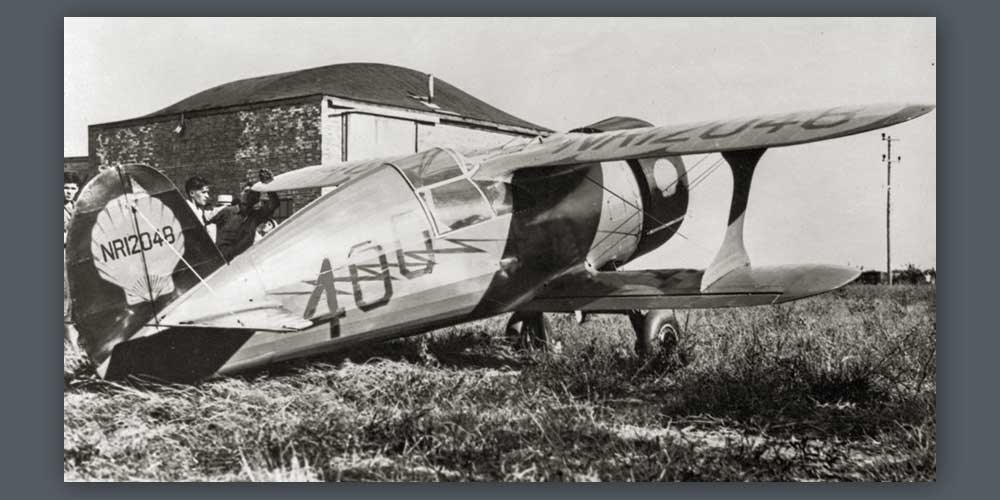
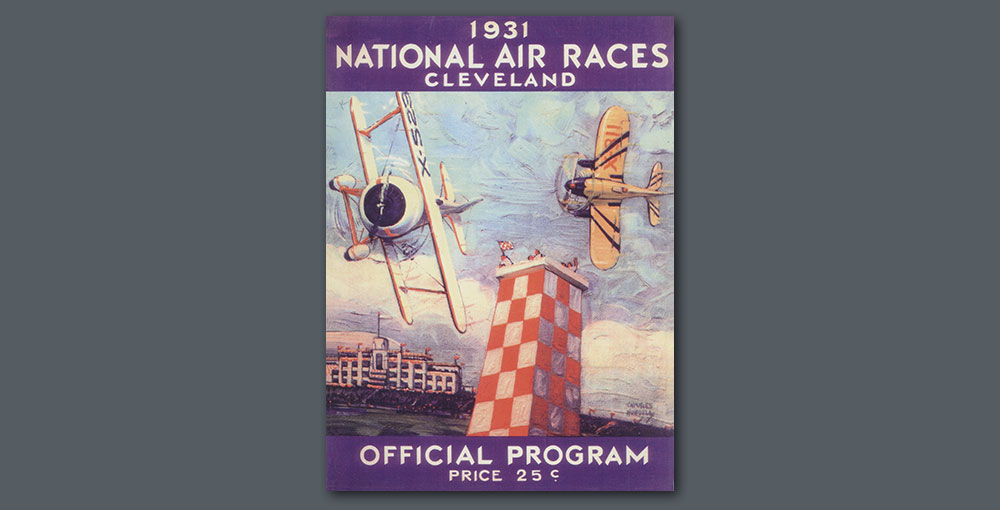
Doolittle returned to Cleveland and prepared for the closed-course Thompson Trophy Race. The race was established in 1930 by Charles Edwin Thompson of Thompson Products, Inc. of Cleveland and Detroit, manufacturers of aeronautical equipment, their most important being sodium cooled valves. It was an international free-for-all for men pilots only and engines of unlimited cubic inch displacement. More than 60,000 spectators would stand enchanted as the world's fastest, most powerful racers dashed 10 times around the Thompson's 10 mile course. In 1931 time trials preceded the big event. The qualification course was a straight path in front of the grandstands with each hopeful flying two speed dashes in each direction. This would give the pilots a chance to check out their planes and by requiring at least 175 mph to qualify, would help insure keeping them in a pack during the main race.
The small group of trained personnel assigned to the "Super Solution" were busy removing the direct drive Wasp Jr. and fitting the geared engine, shipped from Laird's Chicago plant, onto the plane's mount. On Doolittle's first test run the big engine, slinging its nine foot propeller, gave the plane about eight miles per hour more speed, but she had a strong tendency to roll to the left. She was hurriedly rigged right wing heavy, and Doolittle notified the timers he was ready to make his qualification runs. He took the green and yellow bullet up and flew a couple of laps around the pylons indicating 240 mph on part throttle. Then he headed down the home stretch past the grandstand and over the qualification course. He rocked the wings as a signal for the ground timer indicating this was a timed run, but the roll was so slight that Jimmy was uncertain if the timer had noticed it. The Thompson course was an irregular pentagon and Jim came down the stretch, flipped around the first and second pylons but at the third, where the angle was sharper, the left wing would not come up. He found himself unable to recover until he had made a complete roll. As he fought the controls he barrelled to the right, attempting to get back on course. Then he had trouble getting out of the right bank. By this time, Jim reflected, the timer must think he was horsing around. At No. 4 pylon Jim banked left but again the bank increased. Suddenly the controls reversed and Jim throttled back to regain control. The speed during the run had been clocked at 260 mph.
Doolittle landed the plane to have the rigging checked, but nothing appeared to be seriously wrong. Jim took her up again and made another attempt at the three kilometre straight-away Thompson qualification course. On the first pass the plane rolled to the left until almost out of control. Jim chopped the throttle and she smoothed out. Apparently the roll instability got much worse at faster speeds. So, for his second pass, Jim decided to experiment by entering the course with the right wing down about 30°. The racer had now accelerated, and as the one kilometre marker flashed she was rolling against the stick, her wings already level. By two kilometres the left wing was down some 30 degrees and depressing rapidly. Again Jim was forced to throttle back, unable to make even one satisfactory pass across the course.
It was now apparent that something was progressively loosening up. The wings were warping in flight, and rough air encountered on one of the speed runs made the rigging so flabby that Jim could actually watch a lateral wiggle along the upper wing trailing edge. He commented later, "The racer was extremely tempermental to rig. Here was an airplane that could be rigged in flight. The difficulty was that it wouldn't hold its rig. "In this airplane," he continues, "the main wing truss was incomplete. The auxiliary wing truss had depended upon a fitting around the center of the continuous rear spar in the upper wing to take unevenly distributed wing loads. A careful inspection showed that the spar had crushed at this point and the bolt holes had elongated. As a temporary expedient an eighth-inch thick piece of sheet steel was driven between the fitting and the spar to take up the play. This corrected the trouble temporarily, but after a few hours flying it again appeared due to further crushing of the spar."
The Thompson race was scheduled the next day leaving no time to modify the wings, make new fittings or devise new rigging. The geared engine could not be used because its dynamics induced wing warping and aileron reversal as the speed approached 250 mph. Jimmy felt certain he could handle the Super Solution. With the direct drive Wasp, although now it might respond "sloppily," as he put it. The engines were changed overnight and the morning of race day was spent re-rigging the plane.
With the plane again serviceable, a test flight was made to check the Wasp Jr. engine and accomplish the qualifying runs for the Thompson. The only real competition seemed to be coming from Lowell Bayles who clocked a pre-race time trial of 267.242 mph in his radical new Gee Bee Z racer. Doolittle took the "Super Solution" over the qualification course and turned in an average of 255.354 mph, while his fastest lap was a blazing 272 mph. There was no doubt it would be a tight race. Doolittle landed, satisfied he could at least put up a scrapping good fight. Almost at once it was race time. The "Super Solution" had been rigged right wing heavy to aid left bank recoveries, and with hope overiding misgivings, it was rolled to the starting line.
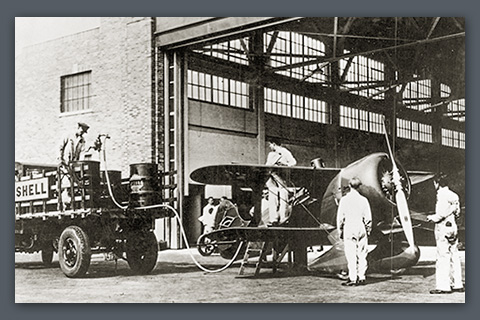
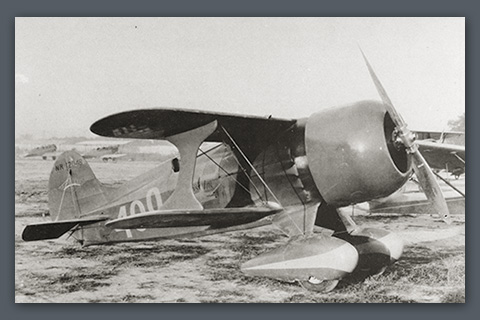
As Jimmy surveyed the line of eight starters he felt fairly confident about the "Super Solution's" chances. If he could get a head start he would have a fighting chance and the racer's poor visibility wouldn't be a factor. Jim was frankly worried to be so restricted in forward view if he had to fly in the midst of several racers. As he assessed his competition, he judged Lowell Bayles his greatest threat, but the sly dark horse could be Jimmie Wedell in his own racer, No. 44.
The starters flag was raised ... held five seconds and dropped. The little racers were off. Doolittle jumped into a commanding lead and streaked for the scattering pylon. He flipped the Laird around the first marker, shaving the pylon with a mere five feet to spare, and charged well out in front as the first lap passed into history. Already the strain was beginning to show on the over-revved direct-drive engine. Jim alone knew this as temperatures- began to climb and gauges went into the red. By the second lap, everyone knew, as smoke belched from the exhaust stacks and trailed off the rudder. With each succeeding lap the Wasp became sicker. Bayles had taken the lead in the third lap, but Jim was determined and grimly hung on until the seventh lap when he finally had to pull out of the race before his engine failed completely. Bayles went on to win the Thompson that year in the Gee Bee, averaging 236.24 mph. Doolittle, despite his ailing engine, had averaged a remarkable 228 mph. Investigation disclosed the Wasp had blown or scuffed a piston.
Recalling this difficulty, Jimmy related, "The fuel used in the (Bendix) was straight run gasoline containing three ccs of tetraethyl lead per gallon and having a knock rating of 87 octane. For full throttle operation, Thompson Race' 89 octane gasoline containing five cc of lead was used. With the 89 octane fuel there was no detonation and head temperatures were steady at about 520" F'." The fuel mixtures were carefully compounded and analyzed by Shell Oil experts and had previously been used in the Wasp engines by Doolittle during earlier tests. He had confidence the high octane fuels would not harm the engine if specific time limits were not violated during full throttle operations. Everything was running smoothly until the one piston was damaged, possibly by a speck of foreign matter. Temperatures began to rise thereafter. The direct-drive Wasp Jr. had done her duty for the Bendix, but the gruelling pressure of the Thompson was the breaking point.
In September 1931 Jimmy Doolittle, with yet another long-distance speed record in mind, flew the "Super Solution" to the Pratt & Whitney plant at Hartford, Connecticut to have its engine majored. On September 18 the racer was rolled into the P & W experimental hangar, and within three days a comprehensive report was released. This indicated the racer weighed 1752 lbs. empty, 2585 lbs. gross, and its direct-drive Wasp Jr. engine was number X-27, which the shop people had originally called the "Yellow Jacket", to continue the series of P & W nicknames, based on stinging insects. As applied to Doolittle's engine, however, the name was unofficial. It was later given officially to an experimental 20-cylinder water-cooled engine which was never produced.
Shortly after the overhaul Doolittle took the "Super Solution" to Ottawa, Canada, the jumping off place for a three capital speed record, including Ottawa (Canada), Washington (U.S.A.) and Mexico City ( Mexico). At about 5 a.m. on October 20, 1931, Jim lifted the stubby little biplane aloft for its first non-stop leg to Washington, D.C. After refuelling there he made a dash for Birmingham, Alabama. The pattern of operation was similar to the successful Bendix race, with Jimmy never on the ground more than 10 minutes at any of the stops. From Birmingham he bored to Corpus Christi, Texas, and after a total of 12 hrs. 36 min. he landed at Valbuena Field near Mexico City. The Doolittle/"Super-Solution" pair had established an inter-city record that challenged speed flyers for several years thereafter.
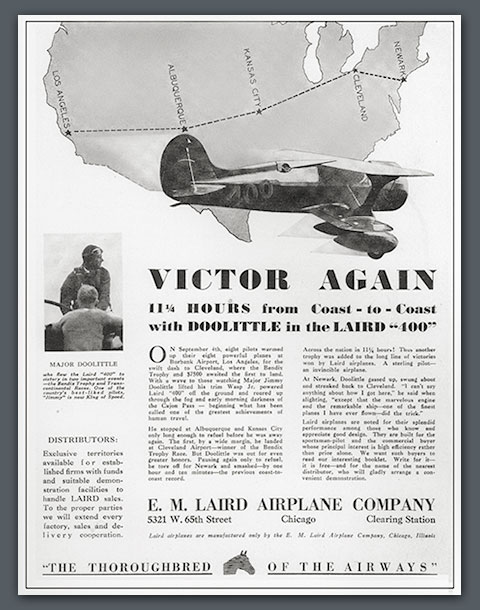
The "Super Solution" proved itself a good, all-around fast airplane suitable for both closed-course pylon races as well as long distance speed flights. Its drawback was poor pilot visibility. Jimmy Doolittle summed it up: "Had we been able to use the cooler-running; geared engine; had the wing trussing been complete or the centre cabane fitting more secure so the wings wouldn't warp; had we known as much then as we know now, none of these difficulties would have arisen ... but that is experience."
In the summer of 1932 Doolittle and Shell Oil Co. officials decided to correct these deficiencies, and Doolittle suggested several considerable modifications. These included a longer, sharper nose cowl to aid engine cooling, engine adjustment to "throw" more oil, installation of an air-cooled oil tank, redesign of the wing trussing, raising the pilot seat 10 inches for visibility over the top wing, and installation of a sliding canopy and door so the pilot could stick his head and shoulders out as an aid in landing. Doolittle also believed that gas capacity should be increased, a controllable pitch propeller employed, the c.g. moved aft to correct excessive longitudinal stability, cockpit ventilation improved, and a retractable landing gear fitted to increase speed.
These modifications were discussed with the Laird Company but their bid for the work was too high. Doolittle took the job to the Christopher Bros. in Wichita, Kansas who completed all the changes he had stipulated by mid August. Doolittle made the first flight in the completely redesigned "Super Solution" at Wichita on August 24, 1932. "It seemed that we had corrected all the faults in the original design," he remarked, "until time came to land. The landing gear, in ground tests, dropped all the way out, then spread and locked into place. In actual flight the air loads and rotation of the slipstream spread the gear before it had dropped out locked it in an intermediate position and it was necessary to make the first landing on the bottom of the fuselage." The gear fault was corrected by using a rubber shock cord which held the wheels together until the telescoping struts were fully extended.
In succeeding flights Jim discovered the plane was subject to bad tail flutter, especially when in slow flight or in landing configuration. The deficiency was attributed to the reshaped fuselage which had been made more rotund in order to accommodate a larger fuel tank located near the c.g. A number of large fillets were tried between the lower wing and the fuselage in attempts to correct this fault, but as August merged into September, trials were still unfinished, and the chance of having all the bugs worked out in time for Jimmy to fly it in the Thompson, held on September 5th seemed bleak. When Doolittle was offered the opportunity by the Granville Brothers to substitute as pilot of the Gee Bee R-1 racer, he took it, and thus set the stage for his historic 1932 Thompson win with the ill-reputed racer.
The brilliantly painted Shell "Super Solution," resplendent in red and yellow decor and looking very little like its old self, stood abandoned in the Wichita hangar for months. Finally it was crated and shipped to the Shell Oil Co. hangar in St. Louis. Here it was shoved from one corner to another slowly gathering dust and losing parts one by one to scroungers.
